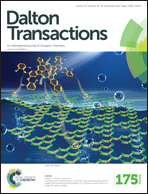Colour tuning by the stepwise synthesis of mononuclear and homo- and hetero-dinuclear platinum(ii) complexes using a zwitterionic quinonoid ligand†
Abstract
The stepwise reaction of a zwitterionic ligand, 4-methylamino-6-methyliminio-3-oxocyclohexa-1,4-dien-1-olate (QH2) with [Pt2(μ-Cl)2(ppy)2] (Hppy = 2-phenylpyridine) afforded a mononuclear complex, [Pt(ppy)(QH)] (1), and a dinuclear complex, [{Pt(ppy)}2(μ-Q)] (2). Using [Pd2(μ-Cl)2(ppy)2] in the second step resulted in the formation of a heterodinuclear complex, [{Pt(ppy)}(μ-Q){Pd(ppy)}] (3), which is the first heterodinuclear complex bridged by a quinonoid ligand. Single crystal X-ray diffraction analysis revealed that all three complexes adopted double-decker structures in the crystal. For 1, intermolecular N–H⋯O interactions between uncoordinated N–H and O groups in two adjacent square-planar mononuclear units led to the formation of hydrogen-bonded dimers, which stacked to form a herringbone structure with a double-decker tetranuclear motif. For 2 and 3, dinuclear units bridged by Q2− formed a double-decker motif similar to that of 1, but a tetranuclear chain in the herringbone pattern was characteristic of the dinuclear complexes. Pt⋯Pt (or Pt⋯Pd) distances were more than 3.5 Å, twice the van der Waals radii of Pt, suggesting weak electronic metal–metal interactions in the crystal structures. Thus, the different colours observed (brown, purple, and dark green for 1, 2, and 3, respectively) mainly originated from the molecular structures. In fact, the three complexes exhibited colourful solutions of yellow, red, and green. UV-vis absorption spectroscopy and time-dependent density-functional theory (TD-DFT) calculations revealed that colour variations occurred depending on the electronic states composed of metal ions and the quinonoid ligand.


 Please wait while we load your content...
Please wait while we load your content...